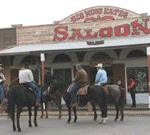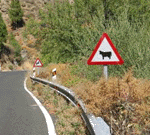|
A Gift of Adventure for Your Horse Lover
|
During the war there was a shortage of young men to manage the cattle herds and as one result the cattle dispersed over the open range. Many of these cattle were Texas Longhorns, a hardy breed which survived and multiplied. As a result, following the war there were a few million head of cattle roaming around free awaiting rounding up.
The problem was, these cattle were a long ways from the east coast and the market for beef. The saving grace was the railroad which, once it reached Kansas (Abilene to be exact) in 1867 became the terminus of the fabled Chisholm Trail over which several million head of cattle were driven up from Texas , through what is now Oklahoma and into Kansas and to market.
These great cattle drives of a thousand miles and more were no longer necessary by the turn of the century once the railroads spread throuout the west and southwest. The cattle drives of today are on a smaller scale, usually for the purpose of moving a herd from one grazing area to another. These are the drives many ranches open up to the likes of you and me, inviting us to join in the fun (and the work).
Cattle drives and roundups often go hand in hand but are not one and the same thing. Before you can drive cattle anywhere you first have to find them. That is the roundup and it can be quite a task. Chances are that's where the bulk of the real work comes in. The length of a roundup would depend upon the size of the herd, how widely the cattle are dispersed, and the terrain they are in.

|

|

|
| First thing is to get the cowhands together. They're usually not hard to find. | Finding the cattle is the next step. Experienced cowhands will look for signs. | A thousand head or just one cow? A plate of ribs awaits you at the end! |
Getting Started
It's always easiest if you know someone who has visited a vacation or outfitter's ranch, been pleased with their experience and recommend it to you. Otherwise go through a reputable tour agency recognizing that these agencies depend upon satisfied, repeat customers and referrals for their own success.
Once you've found a vacation choice that seems attractive you might contact the host, get brochures, and talk directly with the outfitter or ranch owner. It's difficult to judge what a specific cattle drive or roundup will be like from a brief description. Arm yourself with questions - what level of riding experience is needed - what tasks might I be asked to do - what is the duration of the activity - what are the scenic attractions - what are the accomodations - luxury, primitive, or something in between - what do I need to bring , and anything else you can think of that will help make your vacation a wonderful experience.
What are the Requirements?
Most ranches welcome anyone though they may set age limits for cattle drives, 10 or 12 years old being typical. Some will have rider's weight limits, I've seen 250 pounds quoted by several places. The main prerequisites are to be in reasonably good physical condition and be able to ride a horse reasonably well. Best just to talk to the host and find out whether the activity is suited for you.
And the Risks?
Safety is of course a priority but face it, anything longer than a day's trail ride takes on the aspects of an adventure. The weather can turn sour, accidents can happen, and on a long trip the pace may turn out to be too fast, too slow, too rough or too long. It's probably a good idea to put yourself in a frame of mind that what you're about to experience is something new, different, and perhaps a little unpredictable.
|
|||||||||||||||
|
What I Know About Cattle Drives
I can't tell you from personal experience what a cattle drive or roundup is like, only what I think it might be like. You can give yourself a little test by reading "What I Know About Cattle Drives." If you still want to go on one you'll probably do just fine.
Where To Go?
The answer to that is "Wherever you want". Cattle drives and roundups are not restricted to the "wild west" although that is certainly where many are available. They are held throughout the US, Canada, Mexico, Australia, South America and even in Europe.
One thing to bear in mind is that if you are travelling outside of North America, the western saddle is less commonly used and the english saddle is apt to be the saddle of choice. This might come as a shock if you're used to having a saddle horn in front of you. In many areas Australian saddles or McClelland saddles are used for recreational riding. These types are a little easier to get used to if you ride western style.
There are plenty of opportunities here in the west featuring working ranches, great scenery, and hospitable hosts. A few destinations and resources are listed below as a starting point.
- Located in Townsend, central Montana Horseback Vacations in Montana offers about every type of activity you might be interested in, including cattle drives.
- Gordon's Guide to Horseback Riding Holidays has a listing of over a hundred of the finest western horseback riding holidays across North America - dude ranch vacations, cattle drives and working cattle ranches, horsepack trips, trail rides and wagon train vacations.

|

